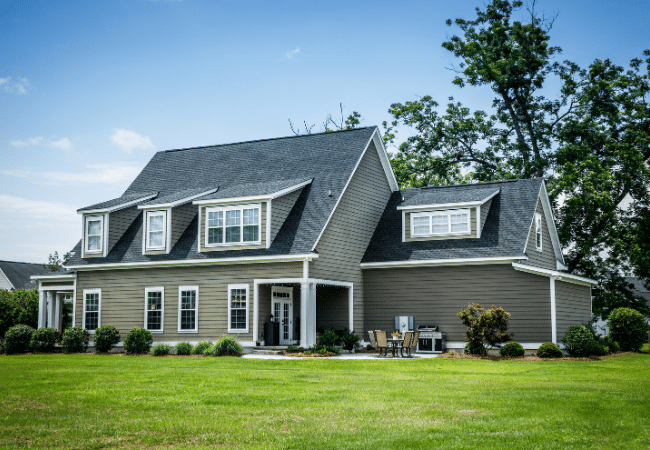What Does Asbestos Siding Look Like?
Roof Right: Exterior Home Remodeling Specialists in Maryland Contact UsSchedule A Free EstimateAsbestos, a once widely used material in construction, has left a legacy that requires vigilance and awareness. In this blog post, we will explore a pressing question for homeowners: “What does asbestos siding look like?” Understanding the appearance of asbestos siding is crucial for identifying potential risks and taking necessary action. If you suspect asbestos in your home, it’s imperative to address the issue promptly. Roof Right, a family-owned roofing company serving Maryland homeowners since 1994, stands ready to assist you with any roof repairs or replacements. Contact us today for comprehensive and reliable roofing solutions tailored to your needs.
What is Asbestos?
Asbestos is a naturally occurring mineral known for its heat resistance, strength, and insulating properties. Due to these qualities, asbestos was extensively used in various construction materials, including siding, insulation, and roofing, from the early 20th century until the 1980s. In homes, asbestos was often employed for its fire-resistant characteristics, durability, and affordability. However, over time, it became evident that asbestos exposure posed severe health risks, leading to respiratory diseases such as asbestosis and mesothelioma. As a result, the use of asbestos in construction materials has been heavily restricted or banned in many countries.
Why Homeowners Should Get Rid of Asbestos From Their Homes
- Health Risks: Asbestos fibers, when disturbed, can become airborne and pose serious health risks when inhaled. Long-term exposure to asbestos is linked to respiratory diseases and various forms of cancer.
- Regulatory Compliance: Many countries have strict regulations regarding asbestos in homes. Ensuring your home is free from asbestos is essential for regulatory compliance and the safety of occupants.
- Property Value: Homes containing asbestos may face challenges in the real estate market. Removing asbestos can enhance property value and marketability.
- Renovation Constraints: Asbestos can limit your renovation options. Many contractors may refuse to work on homes with asbestos-containing materials, making renovations more challenging.
- Environmental Impact: Improper removal and disposal of asbestos can have environmental consequences. Proper removal ensures responsible handling and disposal, minimizing environmental impact.
- Insurance Concerns: Some insurance providers may be hesitant to cover homes with asbestos-containing materials, leading to potential complications in obtaining or renewing homeowners’ insurance.
- Peace of Mind: Knowing your home is asbestos-free provides peace of mind for you and your family, eliminating the worry of potential health hazards.
- Future Maintenance: Asbestos-containing materials may degrade over time, increasing the risk of fiber release. Removing asbestos eliminates the need for future costly maintenance and repairs.
Signs That You Have Asbestos Siding
- Age of the Home: Asbestos was widely used in construction until the 1980s. If your home was built before this period, especially between the 1930s and 1970s, there is a higher likelihood of asbestos-containing materials.
- Shingle-like Appearance: Asbestos siding often mimics the look of shingles, with a distinctive textured surface. If your siding resembles shingles and predates the 1980s, it may contain asbestos.
- Wood Grain Appearance: Asbestos siding designed to imitate wood grain may have a pattern that resembles real wood. This type of siding was popular in the mid-20th century.
- Printed Manufacturer Information: Some asbestos siding may have printed information indicating the manufacturer or date of installation. Check for any such markings.
- Multiple Layers of Paint: Many layers of paint on your siding may indicate its age and increase the likelihood of asbestos presence, especially in homes built before the 1980s.
How to Identify Asbestos Siding
Identifying asbestos siding requires a careful examination of your home’s exterior. Follow these steps to assess the possibility of asbestos in your siding:
- Determine the Age of Your Home:
- Refer to property deeds or construction records to determine the age of your home.
- Inspect Your Siding:
- Look for printed information indicating the manufacturer or installation date.
- Count Layers of Paint:
- Multiple layers of paint suggest an older siding, increasing the likelihood of asbestos.
- Examine Replaced Windows and Doors:
- Check areas around replaced windows and doors for newer siding. Compare it to older sections for evidence of age.
- Assess Siding Characteristics:
- Asbestos was prevalent in siding with a shingle-like or wood grain appearance. If your siding matches these characteristics, asbestos may be present.
- Take a Sample for Testing:
- If suspicion persists, wear a mask and carefully take a sample from a damaged area.
- Place the sample in a baggie and contact an accredited testing lab for analysis.
Why Choose Roof Right for your Siding Repairs in Maryland?
When it comes to siding in Maryland, Roof Right stands out for the following reasons:
- Fully Licensed & Insured: Ensuring the highest level of professionalism and accountability.
- A+ Accredited Member of the Better Business Bureau: Recognized for our commitment to excellence.
- Top Replacement Contractor: Ranked 80th in the United States by Remodeling Magazine, showcasing our expertise in roof replacements.
- Angie’s Super Service Award Winner: Consistently recognized for superior service, reserved for the top 5% of all contractors since 2007.
- Home Advisor Screened & Approved: Our elite service rating reflects our dedication to quality and reliability.
- Customer Satisfaction: A 98% overall customer satisfaction rating based on an independent survey conducted by respected third-party Guild Quality.
- References Available: Access references from previous customers, banks, and vendors to build trust in our services.
- Before & After Documentation: Witness the quality of our work through detailed before-and-after photos.

